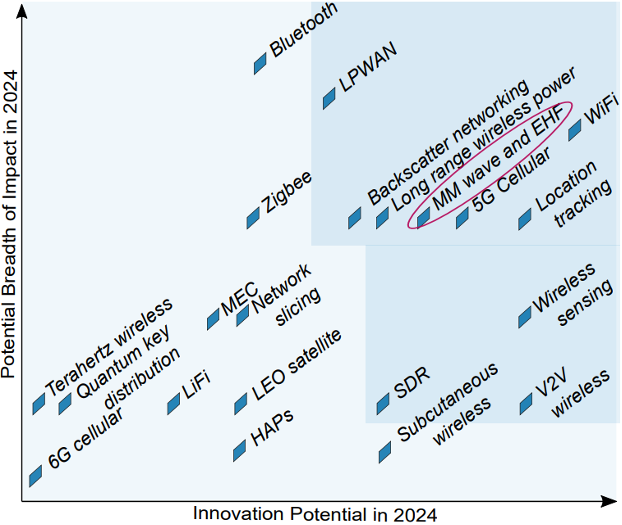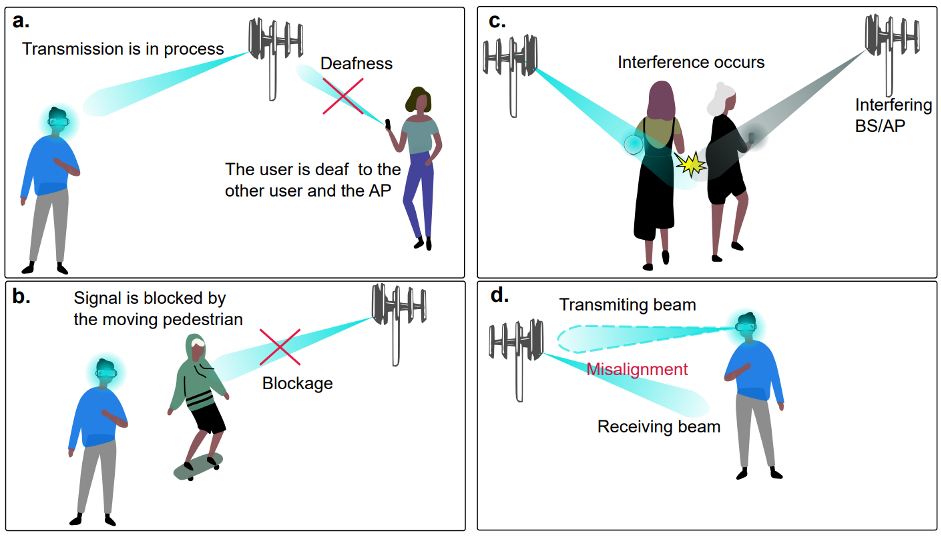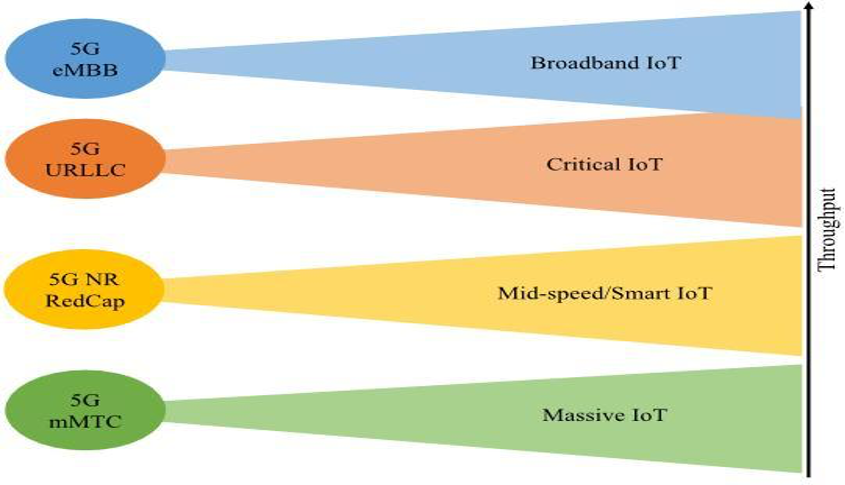High-end wearable applications
Applications involving high-end wearables, such as augmented reality glasses, accurate navigation assistants, virtual reality helmets, goggles, etc., have the intrinsic property of high data-rate requirements. To satisfy these requirements,communication technologies that operate in the millimeter wave (mmWave) and extremely-high frequencies (EHF) are being considered among the top candidate technologies and are being recently included in the top ten trends (see Figure 1) that will drive innovation [1].

Figure 1. Wireless technologies and trends
Operating in mmWave frequencies allows the wireless technologies to achieve gigabits per second throughput in high-end wearable communications, thereby satisfying the requirements of bandwidth-hungry applications, such as virtual, augmented, and mixed reality (AR/VR/MR). However, due to the vulnerabilities to severe path losses, high attenuations, and atmospheric absorptions, transmissions in mmWave frequencies have to be performed through highly directional antennas. Hence, along with the benefits of mmWave transmissions in terms of data rates, there are some technical challenges (see Figure 2) that are faced by mmWave wearable communications and which arise from highly directional transmission mode.

Figure 2. Illustration of challenges, which arise from directional mmWave transmissions
Deafness occurs in wireless directional distributed (ad hoc) networks when the transmitter fails to communicate to its intended receiver because the receiver’s antenna is beamformed in a different direction. As illustrated in Figure 2a, if the transmitter is currently communicating with the VR device belonging to the man in one direction, it cannot receive the request message to establish the communication from the devices located at different locations (e.g., woman’s smartphone). Consequently, the initiator of the request message (woman) will send more messages, increasing the contention window until the packet drops. For more information about the channel access procedure in ad hoc networks, e.g., IEEE 802.11.ad/ay, interested readers can refer to [2]. At the same time, the woman’s messages to the transmitter are blocked, which means that the transmitter is deaf toward the woman’s request and, hence, the deafness problem occurs. Moreover, the deafness problem becomes even worse when the number of devices that receive content from the transmitter increases.
MmWave signals are susceptible to physical blockage and abrupt signal strength variations, which pose another challenge to reliable communication. Various obstacles, such as the mobile user (see Figure 2b), the user’s hand, head (self-blockage), wall, tree, etc., can interfere with the light-of-sight (LOS) link established between the communicating devices, resulting in the attenuation of the received signal.
In the mmWave band, interference between signals cannot be avoided when the number of receiving nodes increases (see Figure 2c). It causes a deterioration in the quality of the received signal (i.e., Signal-to-Noise Ratio), making it impossible to provide high-quality services.
MmWave radios use highly directional antennas to focus the signal power in a narrow beam, thereby compensating for the high path loss. If the communicating devices are static, there would not be any difficulties in aligning their transmit and receive beams. However, it is particularly challenging to deal with mobile users (e.g., VR headsets). In this case, the challenge involves identifying the correct spatial direction that aligns the transmitter’s beamwidth with the receiver’s beam in the presence of mobility. For example, in Figure 2d, we demonstrate the beam misalignment due to the receiver’s movement.
Mid-end wearable applications
Two possible definitions exist for the concept of mid-end wearable applications. The first one can be based on the classification of Internet of Things (IoT) devices into low-end, middle-end, and high-end devices [3]. The second definition is based on the cellular IoT use case categories and their evolution through the 3rd generation partnership project (3GPP) standards [4]. In this blog, we will focus on the second definition and we will try to shed light on this mid-end class of wearable applications from the 3GPP perspective.
With the rapidly growing number of devices being deployed in IoT use cases, the connectivity aspect is becoming more challenging especially when considering the fact that the utilized communication technologies have to meet the network performance required for the wide variety of evolving IoT use cases. By ratifying three service classes supported by the 5G New Radio (5G NR) networks, 3GPP is targeting different IoT use cases. More precisely, the three service classes are enhanced mobile broadband (eMBB), ultra-reliable and low-latency communications (URLLC), and massive machine-type communications (mMTC). By projecting these classes on IoT use cases, three cellular IoT categories were initially defined, namely broadband IoT, critical IoT, and massive IoT. Later on, a fourth category, namely mid-speed/Smart IoT was added, as explained below.

Figure 3. Smart IoT positioning among the cellular IoT segments
5G NR is based on the 3GPP Release 15 standard. The following 3GPP Release 16 standard provides additional enhancements and features to further support the three service classes. However, the ongoing Release 17 (scheduled for June 2021) is addressing new IoT use cases that have throughput needs that are (i) more relaxed in comparison with the eMBB and URLLC services, and (ii) above the throughput capabilities of the low-end mMTC services. This new category is defined as mid-speed or smart IoT (see Figure 3) and includes several mid-end use cases such as mid-end wearable applications. Considering the high data rate requirement in the above-discussed high-end wearable applications, these latter can be classified among the broadband IoT category.
The need for addressing this new category of IoT use cases was seen by many 3GPP-involved companies. This attention resulted in several 3GPP work and study items launched for Release 17 about 5G NR reduced-capability devices, known as NR RedCap. On top of the specification of the potential use cases (i.e., industrial sensors, surveillance cameras, and wearables) and their optimal operation in terms of reduced capability features, these items have opened certain future trends and research challenges for these mid-end applications. Among the mentioned challenges, we can cite the power saving and battery lifetime enhancement, the compensation of device complexity reduction in terms of coverage recovery, the support of high-density scenarios, and the backward compatibility and coexistence with different NR device categories.
References
[1] N. Jones. “The top 10 wireless technologies and trends that will drive innovation.” 2019.
[2] Deng, Jiunn, and Ruay-Shiung Chang. “A priority scheme for IEEE 802. 11 DCF access method.” IEICE transactions on communications 82, no. 1 (1999): 96-102.
[3] Ojo, Mike O., Stefano Giordano, Gregorio Procissi, and Ilias N. Seitanidis. “A review of low-end, middle-end, and high-end IoT devices.” IEEE Access 6 (2018): 70528-70554.
[4] Volker Breuer, Florian Denzin. “3GPP NR interesting times to come for (Smart) – IoT in Release 17.” 2020.
by Asad Ali, Nadezhda Chukhno, and Salwa Saafi

